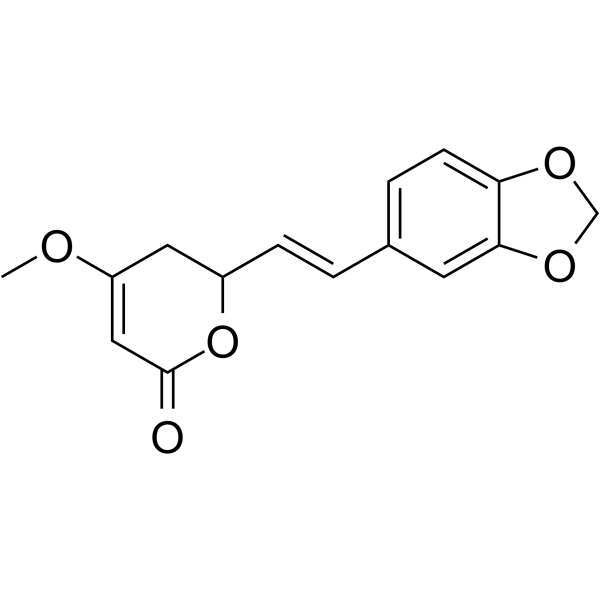
Methysticin b
CAS No. 20697-20-5
Methysticin b( —— )
Catalog No. M31090 CAS No. 20697-20-5
Methysticin, a major kavalactone extracted from kava, can induce CYP1A1.
Purity : >98% (HPLC)
 COA
COA
 Datasheet
Datasheet
 HNMR
HNMR
 HPLC
HPLC
 MSDS
MSDS
 Handing Instructions
Handing Instructions
| Size | Price / USD | Stock | Quantity |
| 5MG | 130 | In Stock |


|
| 50MG | Get Quote | In Stock |


|
| 100MG | Get Quote | In Stock |


|
Biological Information
-
Product NameMethysticin b
-
NoteResearch use only, not for human use.
-
Brief DescriptionMethysticin, a major kavalactone extracted from kava, can induce CYP1A1.
-
DescriptionMethysticin, a major kavalactone extracted from kava, can induce CYP1A1.
-
In VitroMethysticin triggers the most profound inducing effect on CYP1A1. Consistent with the experimental results, in silico molecular docking studies based on the aryl hydrocarbon receptor (AhR)-ligand binding domain homology model also reveals favorable binding to AhR for Methysticin compared with the remaining kavalactones. Additionally, results from a luciferase gene reporter assay suggested that kava extract, Methysticin is able to activate the AhR signaling pathway. Kava extract induces the expression of CYP1A1 via an AhR-dependent mechanism and that Methysticin contributes to CYP1A1 induction. The induction of CYP1A1 indicates a potential interaction between kava or kavalactones and CYP1A1-mediated chemical carcinogenesis. The MTS cell viability assay is used to determine the effects of kava extract and kavalactones on cell viability in mouse hepatic cells. Hepa1c1c7 cells are treated with various concentrations of kava extract (0-50 μg/mL) and six kavalactones (0-100 μM) for 24 h. The results indicate that kava extract at concentrations up to 50 μg/mL and kavalactones up to 100 μM do not induce cell death. For the following studies, kava extract at 0.78-6.25 μg/mL and kavalactones at 0.78-25 μM, concentrations that cause no damage to cells, are used.
-
In VivoThe kavalactone Methysticin (6 mg/kg) is administered once a week for a period of 6 months to 6 month old transgenic APP/Psen1 mice by oral gavage. Methysticin treatment activates the Nrf2 pathway in the hippocampus and cortex of mice. The Aβ deposition in brains of Methysticin-treated APP/Psen1 mice is not altered compared to untreated mice. However, Methysticin treatment significantly reduces microgliosis, astrogliosis and secretion of the pro-inflammatory cytokines TNF-α and IL-17A. Methysticin treatment results in a significant activation of the Nrf2/ARE pathway in hippocampus and the cortex but not in the midbrain and cerebellum of ARE-luciferase reporter gene mice. Methysticin treatment significantly increases the expression of both genes compared to untreated animals.
-
Synonyms——
-
PathwayOthers
-
TargetOther Targets
-
Recptor——
-
Research Area——
-
Indication——
Chemical Information
-
CAS Number20697-20-5
-
Formula Weight274.27
-
Molecular FormulaC15H14O5
-
Purity>98% (HPLC)
-
Solubility——
-
SMILES——
-
Chemical Name——
Shipping & Storage Information
-
Storage(-20℃)
-
ShippingWith Ice Pack
-
Stability≥ 2 years
Reference
molnova catalog



related products
-
Cimiracemoside D
Cimiracemoside D is a natural product from Cimicifuga foetida L.
-
Z-YVAD-FMK
AA-Z-YVAD-FMK is a Irreversible caspase-1 inhibitor.
-
5-amino-1-[4-(triflu...
5-amino-1-[4-(trifluoromethyl)phenyl]-1H-pyrazole-4-carbonitrile is a compound used as a molecular building block.



 Cart
Cart
 sales@molnova.com
sales@molnova.com


